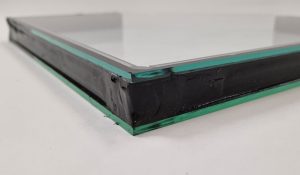How to Stop Condensation on Double Glazed Windows in the Winter

During the colder months of the year, you might notice condensation building up on your double glazed windows. This is a perfectly normal reaction to the temperature difference between the exterior and interior of your windows.
Although this is largely mitigated by high quality double glazing, it is largely inevitable that there will always be a small amount of condensation present during the Winter months due to the levels of humidity in the home.
Read on to find out:
- What is the difference between condensation in double glazing and condensation on double glazing?
- How do I get condensation in double glazing?
- How can I tackle excess double glazing condensation?
- How can I tackle condensation in double glazing?
What is the Difference Between Condensation in Double Glazing, and Condensation on Double Glazing?

If you notice condensation on the outside of your double glazing, this can be indicative that there is excess moisture inside your home. However, condensation on the inside of the double glazed windows themselves can indicate that the sealed unit may be damaged, and potentially need replacing.
Why Do I Get Condensation In Double Glazing?
There are a number of reasons why condensation may occur in your double glazing, and there are solutions to prevent it from happening.
Condensation on windows happens when moist air inside your home meets the cold surface of your double glazed units, which is made cooler by the cold air outside. As the temperature difference is greatest around the edge of the unit due to the aluminium spacer bar, this is where you will most commonly find that condensation forms.
Condensation on windows can be problematic for a number of reasons; firstly, prolonged exposure to moisture around the window seals can cause black mould to form.
How Can I Tackle Excess Moisture on My Double Glazing?
Your windows’ condensation is likely caused by the dew point on the surface of your windows.
If your home is developing a problem with mould, this can easily be tackled with regular cleaning (mould and mildew spray can be especially effective), and wiping down your windows with a dry cloth each morning can help you stay on top of condensation forming.
If you want to reduce condensation on your double glazed window, you may also want to consider how much ventilation your house has.
Older houses often have poorer ventilation without cavity walls, which can greatly impact how your house keeps hold of warm moist air from cooking, drying, washing and bathing.
To begin removing condensation, installing an extractor fan in rooms like the kitchen and bathroom can help to increase ventilation and prevent water vapour from becoming trapped in the room. Steam from boiling pans and bathing can trap warm air inside, leaving more moisture on surfaces like window panes and creating black mould.
Extractor fans can ventilate the warm air outside, and eliminate condensation on windows. You may also want to encourage a habit of leaving the bathroom door open after showering or bathing, so that the wet air does not remain stagnant in the room and condense on the cool surface of tiles and windows.
Alternatively, you can also install windows with trickle vents, which will help with the air circulation of fresh air around the room. Many people assume that trickle vents will encourage heat loss, however, they do not if used correctly. Air vents are vital for ensuring that stale air can circulate out of your home
Additionally, if you use a tumble dryer routinely, you might want to be aware of the excess humidity levels that they can create. Too much humidity can cause condensation on double glazing.
The same is true for drying clothes indoors – the excess moisture combined with warm air from central heating can cause condensation on windows. Ensure to routinely ventilate your rooms by opening windows to allow water vapour to escape and air circulation.
Modern houses are now usually built with air bricks to help with air circulation between floors and in cavity walls, and to prevent warm air from condensing on cold surfaces.
Bedroom windows are especially prone to creating condensation during the night, particularly during the winter. Each adult can produce around half a pint of water vapour while sleeping each night.
To reduce condensation in the mornings, open windows to improve ventilation and reduce humidity in your bedroom. Modern double glazing windows usually have multiple settings for partial opening, where you can retain warmth and keep your house thermally efficient while also preventing a condensation problem.
How Do I Tackle Condensation Inside Windows?
If you can see condensation inside the panes of your double glazed window, this is usually caused by a fault with the sealed unit seal. The spacer bar in most double glazed windows is designed to contain a desiccant to draw small amounts of moisture from the space between the window panes.
However, if the sealed unit is damaged, excessive moisture can become trapped between the two panes. As a result, the desiccant can become saturated with condensed water vapour and will no longer work effectively.
Depending on how bad the damage is, you may need to replace them with some new sealed units. Not only will this help to reduce your energy bills by retaining the warmth of your home with greater efficiency, but this will also improve the quality of your sealed units.
If you’re looking to upgrade your double glazed sealed units, contact Halifax Glass today for high quality service and units to suit your bespoke measurements.


